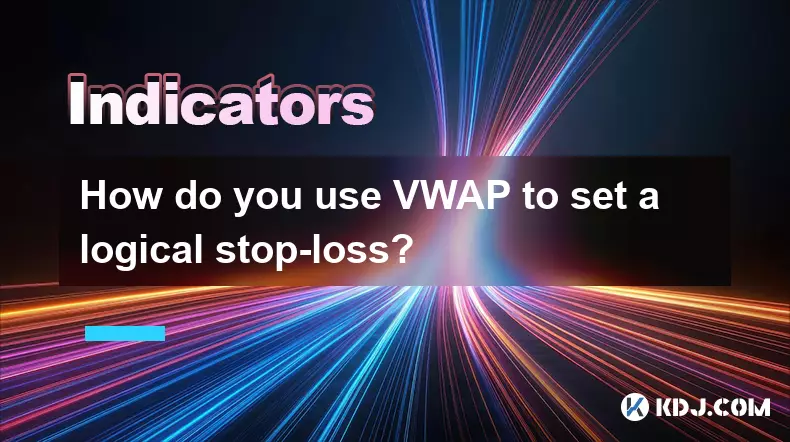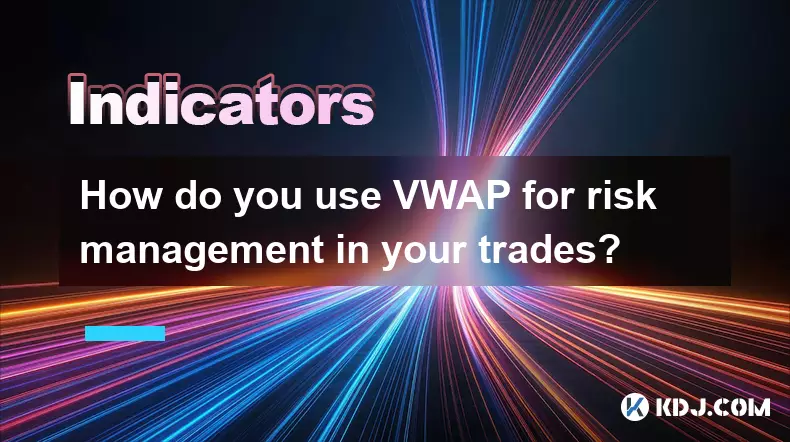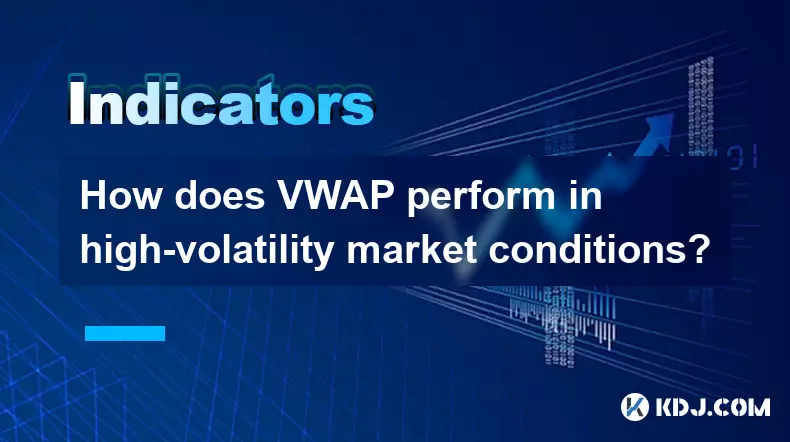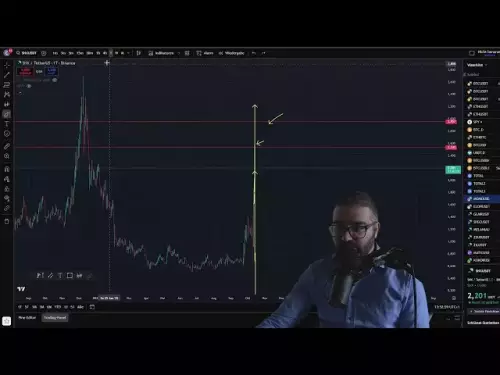-
 bitcoin
bitcoin $115692.075601 USD
5.13% -
 ethereum
ethereum $4162.931611 USD
11.68% -
 bnb
bnb $1310.063287 USD
17.56% -
 tether
tether $1.000983 USD
0.00% -
 xrp
xrp $2.534505 USD
8.16% -
 solana
solana $198.235737 USD
13.49% -
 usd-coin
usd-coin $1.000236 USD
0.02% -
 dogecoin
dogecoin $0.207352 USD
12.89% -
 tron
tron $0.323043 USD
3.62% -
 cardano
cardano $0.701559 USD
11.88% -
 hyperliquid
hyperliquid $39.924597 USD
8.30% -
 chainlink
chainlink $18.934457 USD
11.56% -
 ethena-usde
ethena-usde $1.000552 USD
0.02% -
 stellar
stellar $0.340575 USD
7.05% -
 bitcoin-cash
bitcoin-cash $545.011757 USD
8.86%
How do you use VWAP to set a logical stop-loss?
VWAP acts as a dynamic support/resistance level, helping traders identify trend strength, reversals, and optimal stop-loss placements based on volume-weighted price action.
Oct 13, 2025 at 09:19 am

Understanding VWAP as a Dynamic Support and Resistance Tool
1. The Volume Weighted Average Price (VWAP) is not just a benchmark for institutional traders; it serves as a dynamic equilibrium point in the market based on both price and volume. Traders use this metric to assess whether an asset is being traded above or below its average value per share for the day.
2. When price is trading above VWAP, it often indicates bullish momentum supported by strong buying volume. Conversely, when price falls below VWAP, it may signal weakening sentiment or distribution by larger players. This shift in positioning can help identify potential reversal zones.
3. Because VWAP recalculates throughout the session using cumulative volume, it adjusts to real-time market activity. This makes it more reliable than static moving averages, especially during volatile periods in the cryptocurrency markets where sudden pumps and dumps are common.
4. In fast-moving crypto charts, particularly on 5-minute or 15-minute timeframes, VWAP acts like a magnet. Prices tend to revert toward it after sharp deviations, making it a useful reference for determining when a trend is overextended.
5. For swing and intraday traders, aligning stop-loss placement with key deviations from VWAP increases the probability of avoiding premature exits due to noise while still protecting capital if the trend truly reverses.
Strategies for Setting Stop-Loss Using VWAP Deviation
1. One effective method involves placing the stop-loss just beyond a significant deviation from VWAP, especially after a breakout or pullback. If price moves sharply above VWAP on high volume but then stalls, a stop can be placed below VWAP to protect against a mean reversion.
2. Another approach uses multiple standard deviation bands around VWAP (often called Bollinger-style VWAP bands). A stop-loss might be set outside the lower band in long positions or above the upper band in short positions, depending on the direction of the trade.
3. In trending markets, traders watch for price to remain consistently above or below VWAP. A stop-loss can be adjusted dynamically to just below VWAP in an uptrend, allowing room for normal retracements while exiting if the trend breaks down.
4. Combining VWAP with candlestick structure improves accuracy. For instance, if a bullish engulfing pattern forms near VWAP support, a stop can be placed beneath the low of that candle, using VWAP as confirmation of valid demand.
5. During consolidation phases, VWAP flattens out, signaling indecision. Placing stops too close during these times increases risk of being stopped out by minor fluctuations. Instead, waiting for a clear break above or below VWAP before entering—and setting stops accordingly—reduces false signals.
Incorporating Additional Confirmation Indicators
1. Using RSI divergence in conjunction with VWAP can strengthen stop-loss decisions. If price makes a new high but RSI fails to confirm, and price simultaneously rejects VWAP, it suggests weakening momentum—justifying a tighter stop.
2. Volume spikes that occur opposite to the current trend near VWAP often precede reversals. A sudden surge in sell volume as price touches VWAP from above may indicate distribution, warranting a stop-loss adjustment to lock in profits or minimize loss.
3. Order book depth in centralized exchanges adds another layer. If VWAP rejection coincides with dense liquidity walls on the order book, the likelihood of a sustained move increases, reinforcing the validity of the stop level.
4. Time-based filters improve reliability. Early in the UTC trading day, VWAP is less stable due to limited data. Waiting until at least six hours into the session ensures the average reflects sufficient volume for meaningful analysis.
5. On higher timeframes like the 1-hour chart, anchoring VWAP from the beginning of the day (00:00 UTC) provides consistency across global sessions, helping traders avoid conflicting signals caused by arbitrary chart windows.
Frequently Asked Questions
What happens to VWAP after a major news event in the crypto market?Major news events often cause extreme volatility and volume surges, which significantly shift VWAP. The indicator will reflect the new average cost basis quickly, sometimes creating false breakouts. Traders should wait for stabilization before relying solely on VWAP for stop placement.
Can VWAP be used effectively on lower timeframes like 1-minute charts?Yes, but with caution. On 1-minute charts, VWAP reacts very quickly to small price movements and thin volume, increasing noise. It works best when combined with volume filters or tick imbalance bars to reduce erratic behavior.
Is VWAP suitable for overnight crypto positions?Not ideal. Since VWAP resets daily, holding positions across days requires adjusting strategy. Some traders use anchored VWAP starting from key reversal points instead of daily resets to maintain continuity for multi-day trades.
How does exchange-specific VWAP differ from aggregated VWAP?Exchange-specific VWAP only considers trades on one platform, which may not represent true market-wide volume. Aggregated VWAP across multiple exchanges offers a broader view, crucial in fragmented crypto markets where price and volume vary widely between platforms.
Disclaimer:info@kdj.com
The information provided is not trading advice. kdj.com does not assume any responsibility for any investments made based on the information provided in this article. Cryptocurrencies are highly volatile and it is highly recommended that you invest with caution after thorough research!
If you believe that the content used on this website infringes your copyright, please contact us immediately (info@kdj.com) and we will delete it promptly.
- XRP Price Prediction: Weekend Rollercoaster or Rally?
- 2025-10-12 08:45:16
- Bittensor (TAO): Super Bullish Signals Point to Potential 2x Rally
- 2025-10-11 10:25:12
- Silver Price Correction: Navigating the Dip & Identifying Key SEO Keywords
- 2025-10-11 10:25:12
- Decoding Crypto Trends: Bittensor's Bull Run, Cardano's Dip, and LivLive's Presale Buzz in 'Uptober 2025'
- 2025-10-12 08:45:16
- MoonBull: The Crypto Meme Coin Promising 1000x Gains?
- 2025-10-11 10:30:01
- Crypto Payroll Revolution: Stablecoins, Altcoins, and the Future of Salary Payments
- 2025-10-11 10:30:01
Related knowledge

What's the main difference between VWAP and TWAP?
Oct 12,2025 at 11:54am
Understanding VWAP and Its Role in Crypto Trading1. Volume Weighted Average Price (VWAP) is a trading benchmark that calculates the average price of a...

How do you identify exhaustion moves using VWAP and its bands?
Oct 12,2025 at 08:00am
Understanding the Role of Decentralized Exchanges in Crypto Trading1. Decentralized exchanges (DEXs) operate without a central authority, allowing use...

What are the main advantages of using VWAP over EMA?
Oct 11,2025 at 02:18am
Main Advantages of Using VWAP Over EMA1. Volume-Weighted Average Price (VWAP) incorporates trading volume into its calculation, offering a more accura...

How do you use VWAP on different chart types like Heikin Ashi?
Oct 11,2025 at 05:01pm
Understanding VWAP in the Context of Heikin Ashi Charts1. The Volume Weighted Average Price (VWAP) is a powerful analytical tool commonly used by trad...

How do you use VWAP for risk management in your trades?
Oct 11,2025 at 02:54am
Understanding VWAP as a Dynamic Benchmark1. The Volume Weighted Average Price (VWAP) serves as a crucial reference point in intraday trading by reflec...

How does VWAP perform in high-volatility market conditions?
Oct 10,2025 at 08:00pm
Understanding VWAP in Turbulent Market Phases1. Volume-Weighted Average Price (VWAP) serves as a benchmark for institutional traders aiming to assess ...

What's the main difference between VWAP and TWAP?
Oct 12,2025 at 11:54am
Understanding VWAP and Its Role in Crypto Trading1. Volume Weighted Average Price (VWAP) is a trading benchmark that calculates the average price of a...

How do you identify exhaustion moves using VWAP and its bands?
Oct 12,2025 at 08:00am
Understanding the Role of Decentralized Exchanges in Crypto Trading1. Decentralized exchanges (DEXs) operate without a central authority, allowing use...

What are the main advantages of using VWAP over EMA?
Oct 11,2025 at 02:18am
Main Advantages of Using VWAP Over EMA1. Volume-Weighted Average Price (VWAP) incorporates trading volume into its calculation, offering a more accura...

How do you use VWAP on different chart types like Heikin Ashi?
Oct 11,2025 at 05:01pm
Understanding VWAP in the Context of Heikin Ashi Charts1. The Volume Weighted Average Price (VWAP) is a powerful analytical tool commonly used by trad...

How do you use VWAP for risk management in your trades?
Oct 11,2025 at 02:54am
Understanding VWAP as a Dynamic Benchmark1. The Volume Weighted Average Price (VWAP) serves as a crucial reference point in intraday trading by reflec...

How does VWAP perform in high-volatility market conditions?
Oct 10,2025 at 08:00pm
Understanding VWAP in Turbulent Market Phases1. Volume-Weighted Average Price (VWAP) serves as a benchmark for institutional traders aiming to assess ...
See all articles










































































